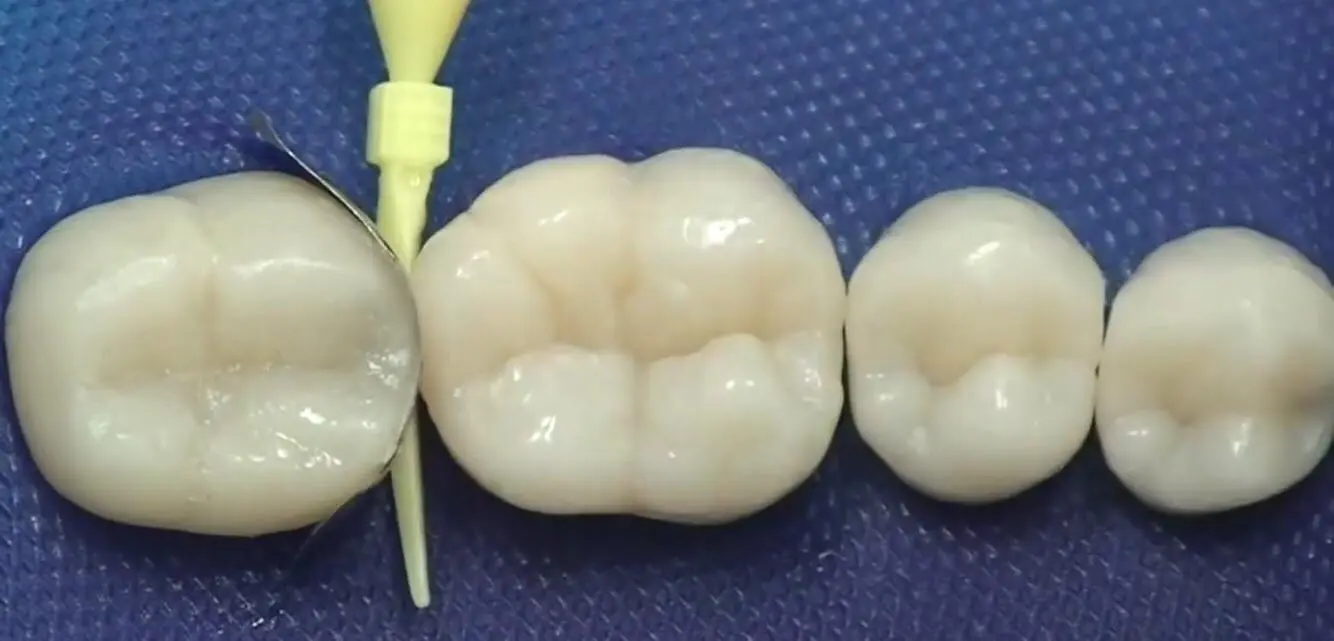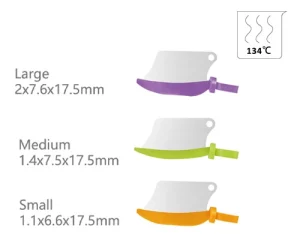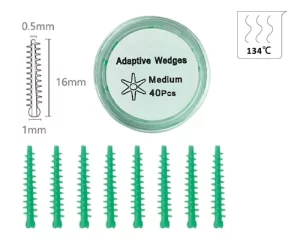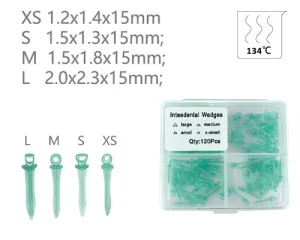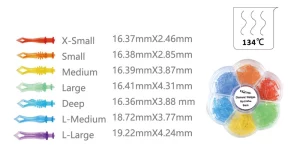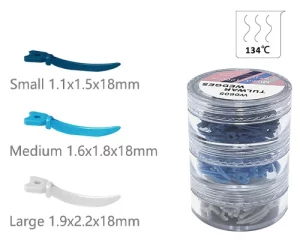작지만, 치과 웨지는 회복 치과에서 대체 할 수없는 역할을합니다. 그들은 주로 치아 분리에 사용됩니다, 매트릭스 밴드를 안정화하고 수복물의 가장자리를 형성합니다. 재료와 디자인에 따라, 웨지의 임상 성능과 사용은 다양합니다. 이 기사에서, 우리는 체계적으로 유형을 분석 할 것입니다 치과 웨지, 그들의 재료 특성, 그들의 주요 기능과 충전 및 복원에서의 적용.
1. 치과 웨지 및 재료 특성의 유형
플라스틱 치과 웨지
재료: 종종 의료 폴리 프로필렌으로 만들어졌습니다 (pp), 유연한.
장점:
- 적당한 탄력성은 잇몸의 압력을 감소시킵니다.
- 고온에서 멸균 될 수 있으며 재사용에 적합합니다..
단점:
- 제한된 지원, 사례에 적합하지 않습니다 깊은 충치 또는 단단한 간격.
샘플 디스플레이:
- 치과 웨지 가드 (GD-5675): rblade가있는 구멍
세 가지 크기: 큰/중간/작은

- 적응 형 웨지 (GD-5677): 확고한 내부 플라스틱 코어, 실리콘으로 덮여 있습니다

- 수지 치과 웨지 (GD-5678): 4 개의 크기, XS/S/M/L

- 다이아몬드 웨지 (GD-5679): 일곱 크기, x-small/small/medium/large/deep/l-medium/l-large

- 툴와르 웨지 (GD-5680): 세 가지 크기, 중소/중간/큰

나무 치과 웨지
재료: 대부분 자작 나무 나 소나무, 멸균. 수분 함량이있는 자작 나무 웨지 12% 최대까지 확장 할 수 있습니다 18.7% ~에 30 치은 유체 환경에서 분. 이 적응 형 속성은 노인 환자의 치은 불황 사례에 특히 적합합니다.. 하지만, 주의를 기울여야합니다: 과잉 확장은 치주 막에 과도한 압력을 초래할 수 있습니다., 수술 후 감도를 유발합니다.
장점:
- 자연스럽게 흡수 및 팽창성, 수술 중 갭에 더 잘 맞습니다.
- 엄격한, 클래스 II 공동의 고강도 지원에 적합합니다.
단점:
- 쓸 수 없는, 과잉 확장은 불편 함을 유발할 수 있습니다.
샘플 디스플레이:

다른 유형
- 금속 웨지: 희귀한, 전체 크라운 준비 또는 특별한 회복 시나리오에 일반적으로 사용.
- 실리콘 웨지: 부드럽고 유연합니다, 미적 수복에 적합합니다, 그러나 더 비싸다.
2. 치아 웨지의 세 가지 핵심 기능
치아 분리
- 인접한 이빨을 일시적으로 분리합니다 0.2-0.5 작동 공간을 만들기위한 가벼운 기계적 힘이있는 mm.
- 이것은 돌출되지 않고 복원을 방지하고 이웃 지점의 자연스러운 모양을 복원합니다..
- 임상 연구는 웨지의 적절한 사용이 음식 충격의 위험을 최대까지 줄일 수 있음을 보여줍니다. 60%.
매트릭스 밴드 안정화
- 치과 웨지는 성형 조각을 고정하는 데 도움이 될 수 있습니다, 회복 재료의 누출 방지 및 이상적인 윤곽을 형성.
- 공동 II 복원: 와의 조합 매트릭스 밴드 안정화는 고전적인 솔루션입니다.
- 캐비티 클래스 v 수복물: 일반적으로 곡선 성형 플레이트와 함께.
잇몸 보호 및 지혈
- 치과용 웨지는 잇몸 위를 어느 정도 보호할 수 있습니다..
- 덴탈웨지를 치아에 삽입한 후, 잇몸에 약간의 압력을 가할 것입니다., 수술 중 출혈 감소.
3. 충진 및 수리 응용 기술
올바른 쐐기를 선택하는 방법
| 기준 | 권장 웨지 유형 |
|---|---|
| 좁은 공간 공간 | 나무 웨지, 젖으면 늘어나서 서로 맞아요 |
| 넓은 공간 공간 | 플라스틱 쐐기, 신축성 있는 핏 |
| 가벼운 수지 | 투명한 플라스틱 웨지, 빛의 침투를 촉진 |
| 아말감 충전 | 나무 웨지, 더 강력한 지원을 제공할 수 있습니다. |
각도와 방향을 삽입하세요.
치과용 웨지는 치아의 설측 또는 협측에서 치간 공간으로 비스듬하게 삽입되어야 합니다., 각도는 30°~45°로 조절해야 합니다.. 이 Angle 디자인의 핵심 목적은 잇몸 조직을 피하는 것입니다., 수직 삽입 시 잇몸이 직접 압박되거나 긁히는 것을 방지, 수술 후 잇몸 발적의 위험을 줄입니다., 붓기와 출혈.
삽입 깊이 조절
웨지의 상단은 수복물의 가장자리보다 약 0.5mm 정도 높아야 합니다.. 이 예약된 공간은 후속 충전재의 경화 과정 중 수축을 보상하도록 설계되었습니다. (수지와 같은), 경화 후 재료가 치아 가장자리에 밀접하게 접착될 수 있는지 확인하고 2차 우식으로 이어질 수 있는 틈의 형성을 방지합니다..
임상적 주의사항
잇몸에 과도한 압력을 가하지 마십시오: 수술 중, 치과용 웨지의 삽입력을 조절해야 합니다.. 과도한 압력은 잇몸과 치아의 부착관계를 손상시킬 수 있습니다., 수술 후 잇몸퇴축을 유발할 수 있는. 임상 통계에 따르면 그러한 합병증의 발생률은 대략 다음과 같습니다. 3% 에게 7%.
삽입 위치의 정확한 위치 지정: 치과용 웨지가 오프셋된 위치에 삽입된 경우 (교합면이나 치근 끝 방향에 너무 가까운 경우), 인접한 치아의 접촉점이 너무 느슨해질 수 있습니다., 이로 인해 정상적인 교합 관계의 안정성에 영향을 미칩니다.. 환자는 약한 물림 및 음식 충돌과 같은 문제를 경험할 수 있습니다..
실제 사례: 깊은 쐐기형 결함 수리
좌측 하악 제1소구치의 깊은 쐐기형 결손의 수리를 예로 들면, 구체적인 수술 및 치료 효과는 다음과 같습니다:
- 수술 전 평가: 환자는 45세 성인이었다.. 왼쪽 아래 첫 번째 소구치의 치경 결손이 깊은 상아질까지 도달했습니다., 명백한 감기 및 열 민감성 증상을 동반함. 시각적 아날로그 척도 (VAS) 민감도 정도를 평가하는 데 사용되었습니다., 점수로 6/10.
- 주요 운영 기술: 첫 번째, 아니오를 사용. 00 치은 배액 치료를 위한 치은선. 그 다음에, 미리 적셔둔 소나무 쐐기를 넣고 잠시 기다리세요. 15 치아 간격을 넓히기 위해 완전히 팽창할 때까지 몇 분. 다음, 유동성 수지를 베이스로 사용, 그런 다음 3M Z350XT 수지를 층상 충전에 사용합니다.. 웨지는 충전 공정 중 재료 변형을 방지하기 위해 제거하기 전에 수지가 처음 경화될 때까지 유지해야 합니다..
- 수술 후 효능: 환자는 수술 후 1년 동안 추적관찰 중이다.. 검사 결과 수복물의 완전성 비율이 도달한 것으로 나타났습니다. 98%, 느슨해짐 없이, 박리 또는 이차 우식. 환자의 추위와 열과민 증상이 완전히 사라졌습니다., 그리고 교합기능은 정상으로 돌아왔습니다.
4. 덴탈 웨지 구매 기준
재료 안전 우선 순위
핵심인증기준
웨지의 재질 및 멸균 처리는 전문 의료 기준을 준수해야 합니다.. 다양한 재료는 명확한 인증 요구 사항에 부합합니다.:
- 플라스틱 웨지: FDA가 있어야합니다 (미국 식품의약청(FDA)) 또는 CE (유럽 연합 제품 안전 인증) 의료용 폴리머 인증. 코어는 프탈레이트 등 유해물질을 피해야 합니다., 접촉을 통해 이동하여 잠재적인 건강 위험을 초래할 수 있는 것. 규정 준수 인증은 재료의 안전을 보장하는 핵심 기반입니다..
- 나무 웨지: 완전한 EO (에틸렌옥사이드) 멸균 보고서를 제출해야 합니다., 보고서에는 생물학적 부하가 ≤10⁻⁶임을 명확하게 명시해야 합니다. (즉., 멸균 후 미생물이 생존할 확률은 백만 분의 일을 초과하지 않습니다.), 교차 감염이나 수술 후 염증을 피하기 위해 사용하기 전에 병원성 박테리아가 남아 있지 않은지 확인하십시오..
조달의 함정을 피하기 위한 핵심 사항
구매시, 비의료용 등급 제품에 주의하고 특히 거부하십시오. “산업 나무 쐐기” 표시도 없이. 이러한 제품의 대부분은 산업 공정에서 남은 재료로 만들어지며 의료 등급 처리를 거치지 않았습니다.. 포름알데히드와 같은 유해한 화학 물질이 포함되어 있을 수 있습니다.. 사용시, 잇몸 조직을 쉽게 자극할 뿐만 아니라 구강 점막을 통해 흡수될 수도 있습니다., 환자의 건강에 위협을 가하는 행위. 게다가, 크기와 경도에 대한 통일된 표준이 없습니다., 치아 복원의 정확한 작동 요구 사항을 충족할 수 없는.
사이즈 적합률 극대화
웨지를 선택할 때, 실제 임상적 요구를 결합하고 이를 통해 사이즈 적합도를 극대화하는 것이 필요합니다. “수술 전 평가 + 다중 사양 예약”.
수술 전, 필요한 쐐기의 크기는 처음에는 영향을 받은 치아의 치간 간격의 너비를 기준으로 결정되어야 합니다. (치간 우식증과 같은, 쐐기 모양의 결함 간격) 그리고 치아 형태 (유치, 영구치 같은, 정상 치아와 경사 치아).
다양한 크기의 웨지를 비축하는 것이 좋습니다. (얇은 것 같은, 중간, 두꺼운, 또는 특별한 치아 간격을 위한 얇고 두꺼운 스타일) 싱글 사이즈 부족으로 인한 핏 불량을 방지하기 위해, 이는 간격 개방 효과에 영향을 미치거나 잇몸 압박을 유발할 수 있습니다.. 이를 통해 다양한 사례에 대해 일치하는 모델을 찾을 수 있습니다., 운영 효율성 및 복원 품질 향상.
5. 결론
치아 웨지는 크기가 작아 보잘 것 없어 보이지만, 그들은 없어서는 안 될 존재야 “주요 지원 역할” 치아 복원 작업 중. 재료 선택부터 표준화된 사용까지, 모든 링크에 대한 정밀한 제어는 수복물의 안정성을 강화하고 수술 후 합병증을 줄이는 핵심 보장일 뿐만 아니라, 뿐만 아니라 환자의 진단 및 치료 경험을 효과적으로 향상시키고 장기적으로 좋은 예후를 위한 기반을 마련할 수 있습니다..

